AI in communication: How businesses are using AI to improve internal and customer communications

Director of Content

Tags
Share
As AI tools become more ingrained in our everyday lives, both at work and at home, communications seem to be one area that’s already changed quite a bit.
There’s a huge variety of tools, from AI that can analyze phone calls, to AI that can transcribe conversations in real time, to of course, all the exciting generative AI use cases that are making the headlines every day.
So, how can you use AI to communicate more effectively with your teammates and customers? We’ll walk you through a few examples of how to do this in different industries too below.
How is AI being incorporated into business communication?
More and more, AI is being brought into business communications in different ways to make us more productive and improve the customer experience.
For example, many of us are familiar with support chatbots and conversational AI for customer service when we go on websites to buy things or book appointments.
If you’re a customer, being able to find answers and do simple tasks like change your flight using an AI-powered chatbot is probably a lot more convenient than waiting for hours on hold.
Typically, these AI tools use NLP (Natural Language Processing) to understand the inputs (basically, the questions or requests that you type in) and pull the right information to respond to those inputs.
Dialpad Ai Contact Center, for example, can even analyze the sentiment of customer calls—as they’re happening:

This means that contact center supervisors can easily see if any of their agents need help and open up the live transcript to get more context before deciding if they need to jump in and barge the call.
Even if you don’t deal with customers, you might also be using AI tools that can transcribe your video meetings or conference calls (more on this in the next section).
And fun fact: If you use Gmail or an email client that auto-completes your words and sentences for you… That’s a form of AI too!
Examples of AI in team communications
Now, let’s look at a few ways to use AI in everyday communications with your team members.
Real-time meeting transcriptions
Sometimes, people might show up a few minutes late to a meeting. Or you don’t have someone to take notes. That’s okay. AI transcription tools can take care of that for you.
Things to keep in mind: Not all AI transcription apps have the same level of accuracy, and if you don’t want to be toggling between a bunch of different apps, it’s generally best to use a video conferencing or unified communications platform that has AI transcription built in.
(If you’re interested in learning more about AI transcription accuracy, our team wrote a really interesting piece about how it works.)
This way, you won’t have to buy and juggle different apps or invite a bot attendee to the meeting. With Dialpad, for instance, you just hit the “Ai on / off” button in your video call screen to turn AI transcription on or off:
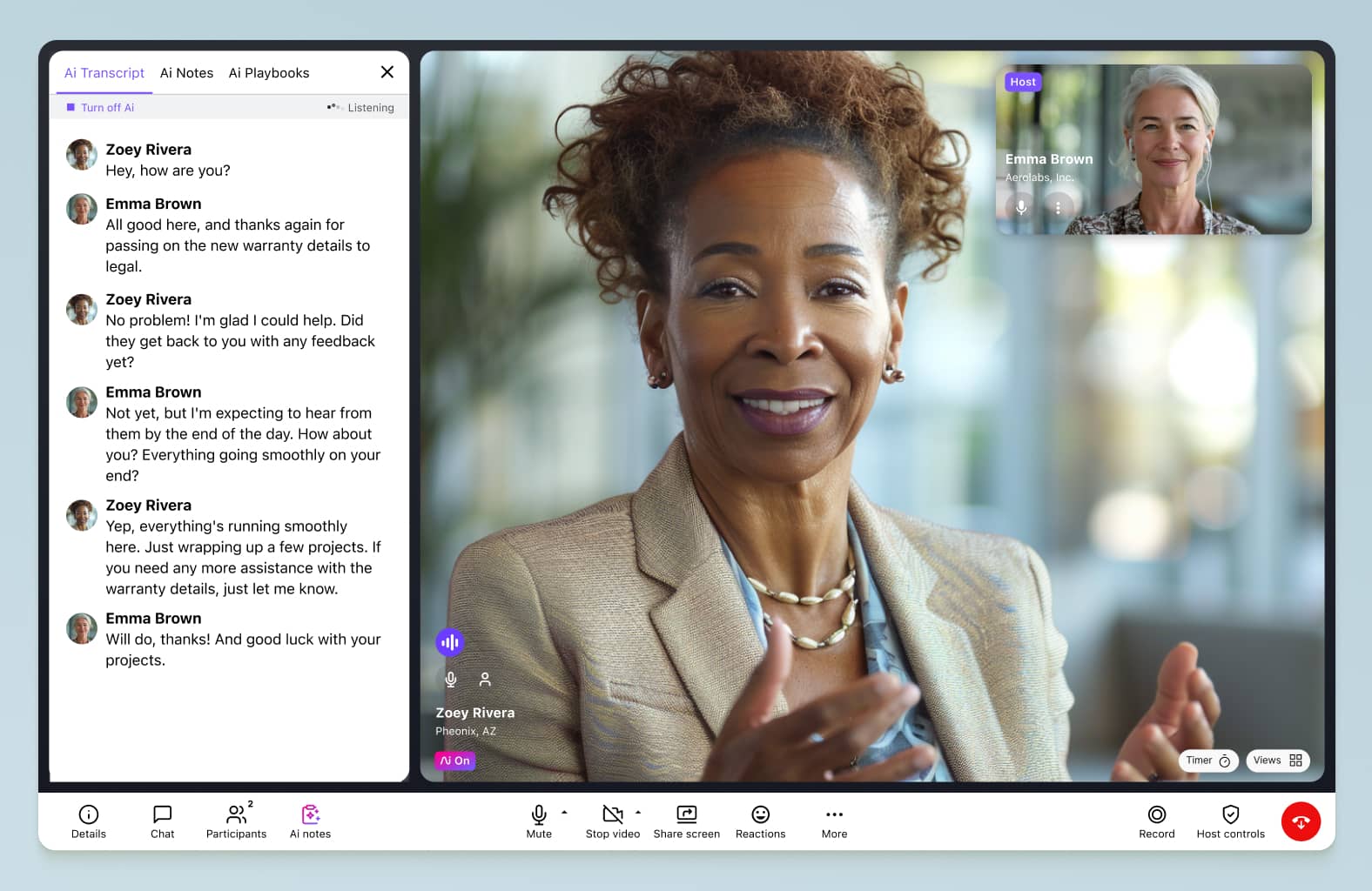
Meeting summaries
To take things a step further, AI-powered solutions like Dialpad can even summarize what happens in your calls in a recap and log any follow-up items:
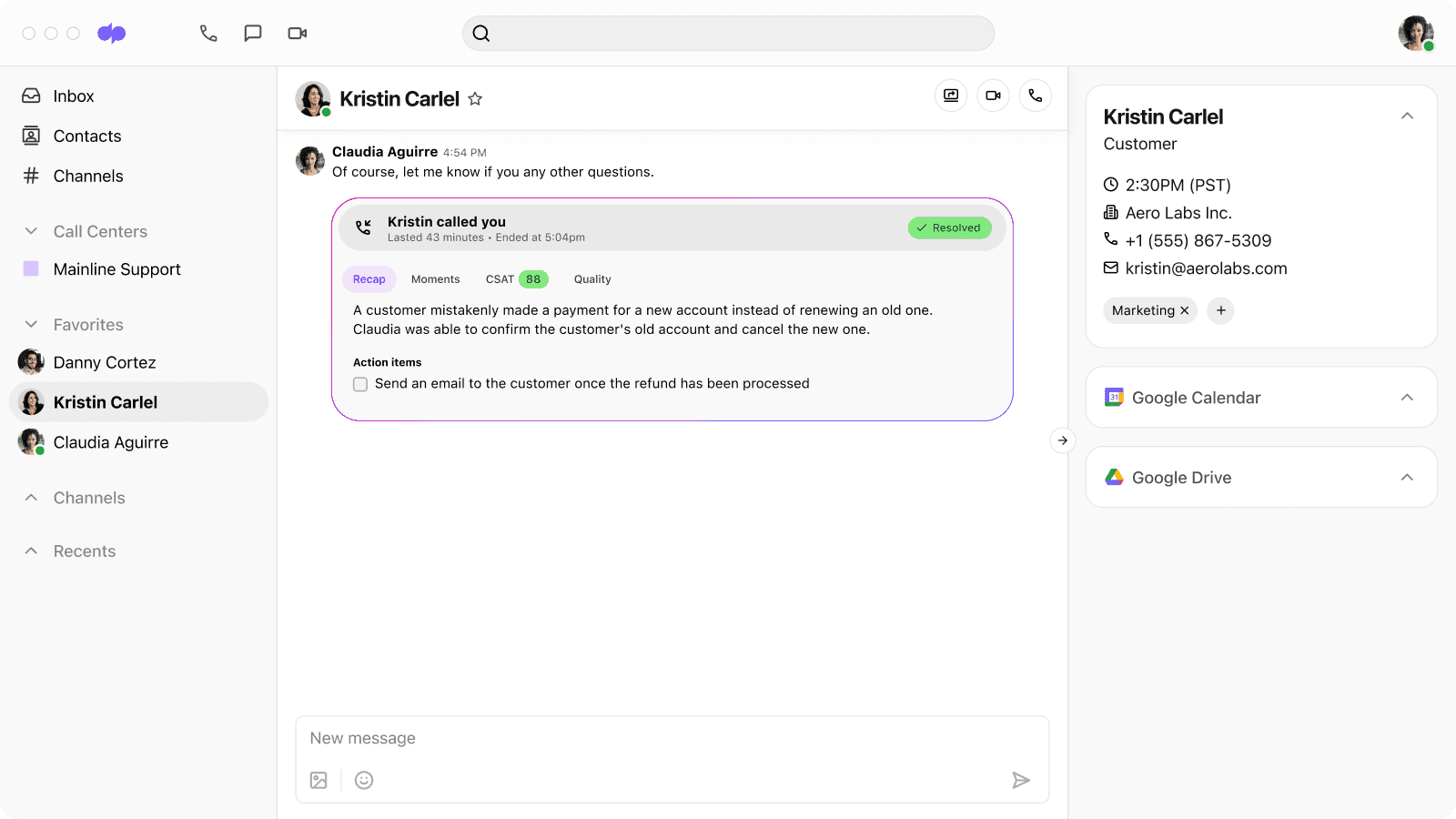
This is especially helpful if you’re in a lot of back-to-back meetings and don’t always have time after each one to make a note of whether you have action items or other things to follow up on.
Email auto-complete
As I mentioned earlier, almost everyone has probably used this AI communication feature already… I know I do. It’s just a convenient little time-saver. And I’m even starting to see auto-completes in other forms of communication too, like texting and inside writing tools like Google Docs. (They call it “Smart Compose.”)
QA scoring
This one is a bit of an interesting one because technically contact center quality assurance is something that a customer support team (or other customer-facing team) does to make sure they’re providing a high enough level of service and keeping customers happy.
However.
I’d consider the QA process part of your “internal communications” too, because this whole process is about your supervisors being able to communicate to their agents about what they’re doing well and where they need to improve. In other words… team communication.
So how can AI help? Well, traditionally managers would have to listen to all their agents’ call recordings from beginning to end, take notes, and then provide that feedback to their agents. It’s pretty time-consuming.
AI can speed up this process dramatically, because it can instantly analyze calls for whether agents did (or didn’t do) the tasks that are part of the QA scorecard criteria.
Dialpad’s Ai Scorecards, for instance, does exactly this—it automatically suggests to supervisors whether an agent adhered to tasks related to things like compliance requirements or sales playbooks, which means managers don’t have to spend hours listening to recordings—and they can more easily point to specific behaviors or opportunities for improvement to help their agents:
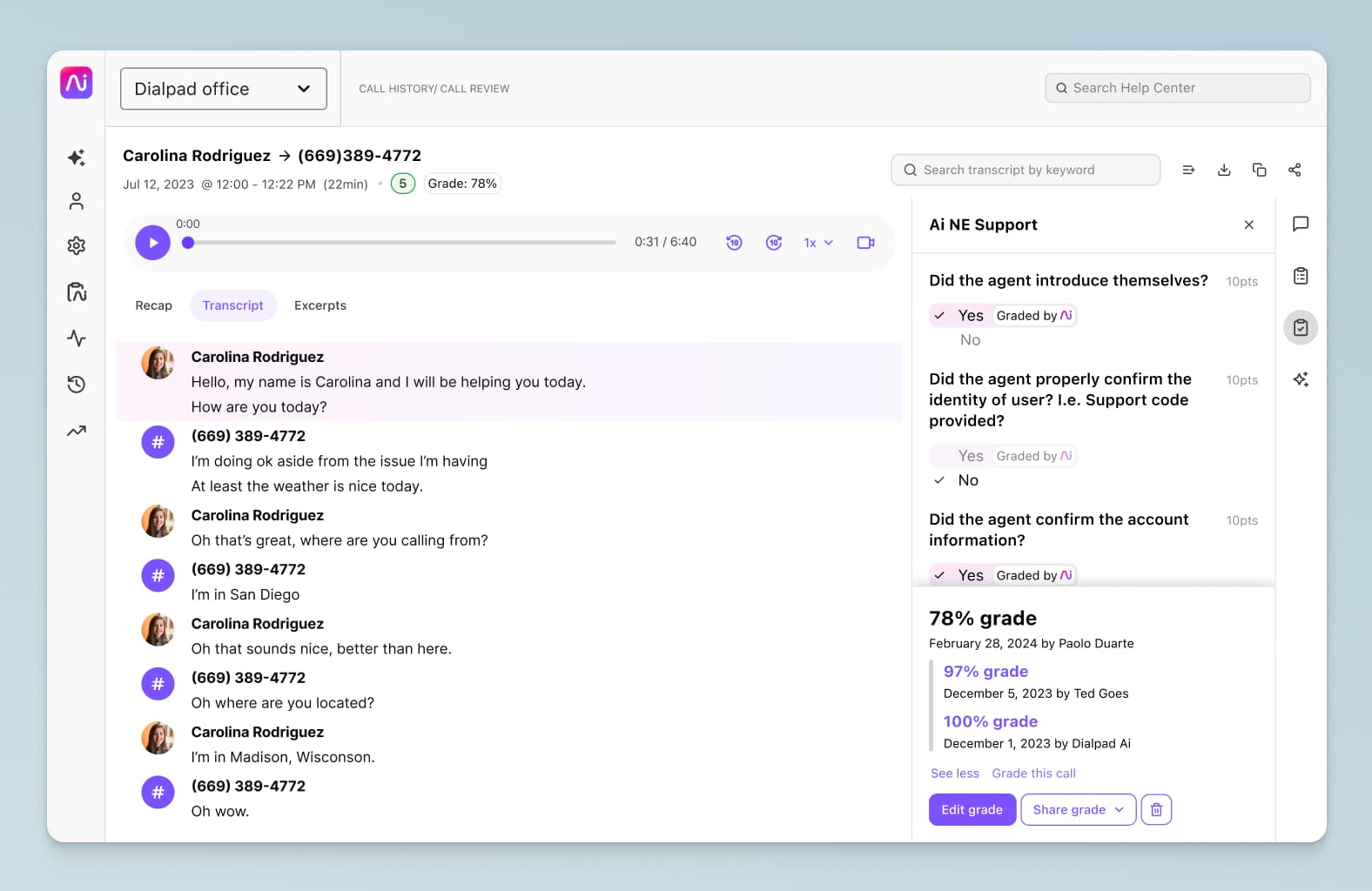
How is AI changing customer communications in different industries?
Now, let’s look at examples of AI in customer communication. We’ll go through how this might look in a few different industries to give you a sense of the variety of ways AI can be used.
AI in client communications for law firms
In law firms, AI can improve client communications and service in a few ways.
Traditionally, lawyers would need secretaries or transcribers to take notes of client meetings. If they were solo attorneys or didn’t have a large staff, they might even do this themselves.
Not anymore. AI-powered communications and legal conferencing solutions can transcribe these calls in real time and even send the summaries to attendees after the call has ended:
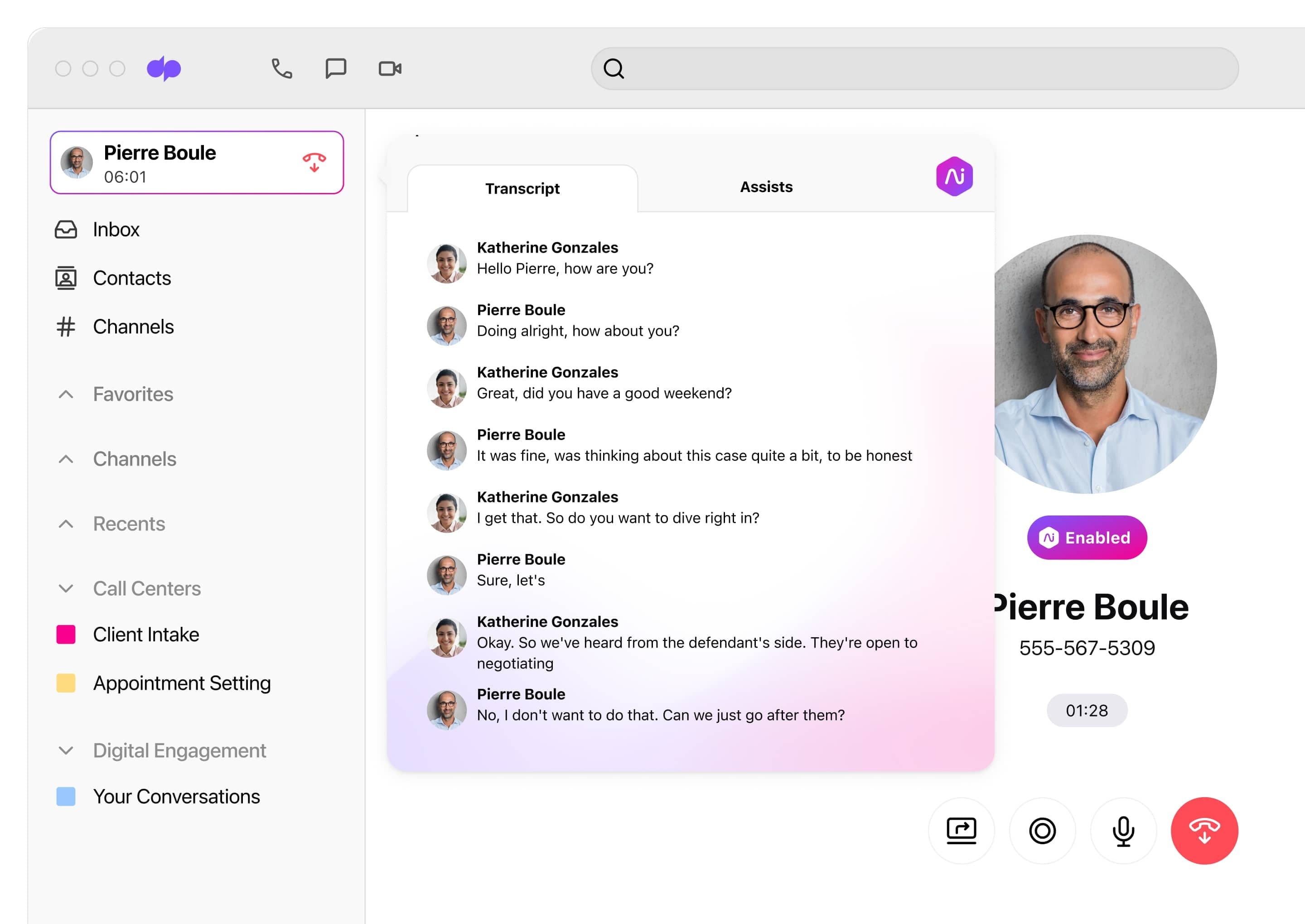
This means attorneys can focus on the conversation (and their client) instead of on taking notes.
For larger law firms, AI-powered chatbots or virtual assistants can handle client inquiries, answer legal questions, and direct clients to the appropriate resources or legal team members who are best suited to answer their questions.
Dialpad Ai Contact Center, for example, makes it easy to drag-and-drop a conversational flow together in minutes—no coding needed:
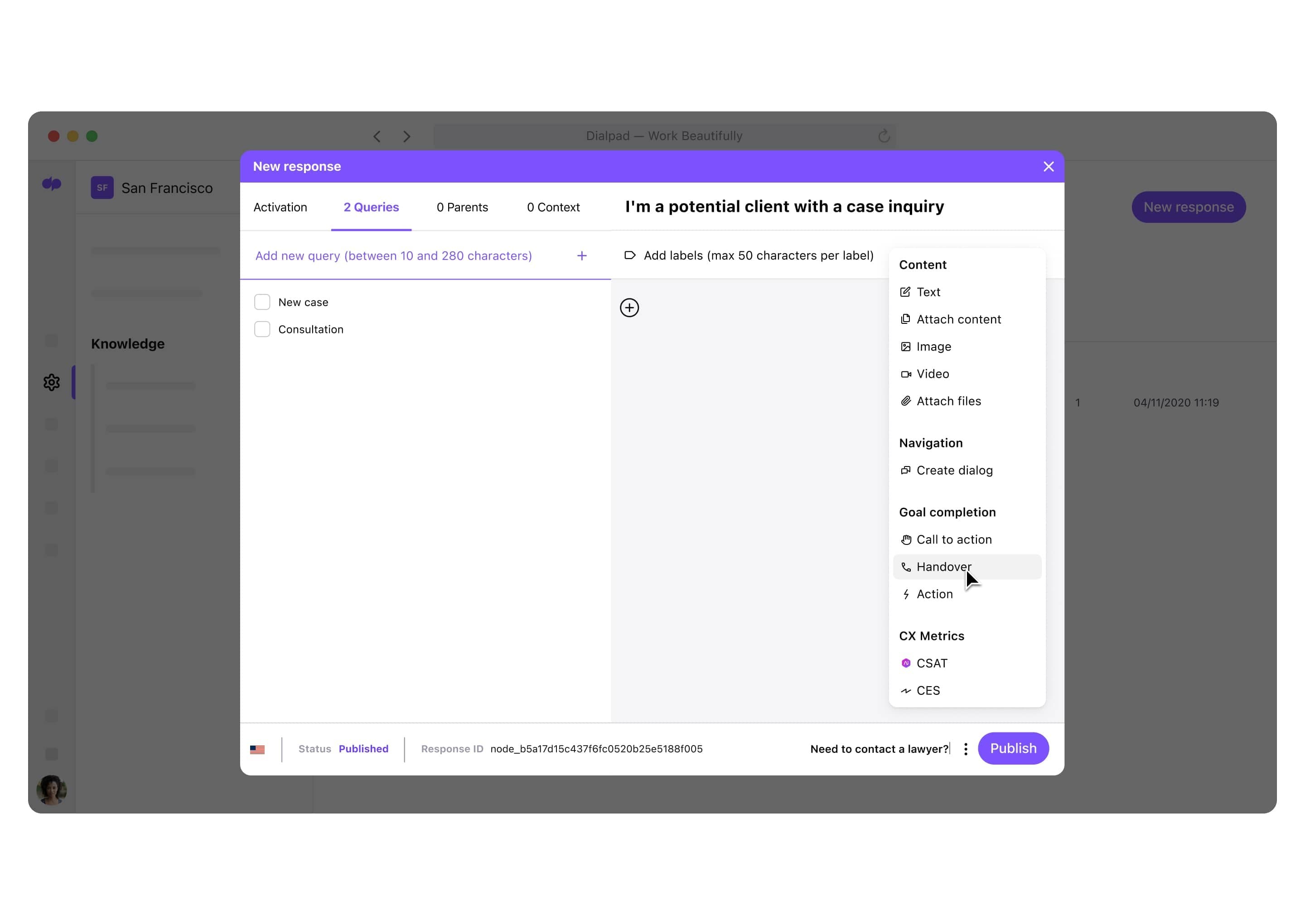
AI can also help human agents when they’re talking to customers. Dialpad Ai can analyze the sentiment of calls in real time, track commonly recurring topics or questions, and even pop up real-time assists with helpful answers when certain keywords or questions are spoken. This provides valuable insight into what clients are happy or unhappy with, frequently asked questions, and other information that can improve training materials for team members and help them answer questions more quickly in the future.
📚 Further reading:
Learn more about AI for lawyers.
AI in customer communications for insurance providers
In the insurance industry, customers often get in touch to learn more about policies, ask for clarifying information about claims, check on claim statuses, and more.
For busy insurance call centers, having AI support can make a huge difference in how quickly (and how effectively) agents can answer customers’ questions. And that’s on top of being able to deflect the less complicated inquiries away from agents too, which reduces wait times for other customers:

Not only that, AI can help agents stay compliant when they’re talking to customers by automatically prompting them to provide disclosures, for example (which is required by Medicare call recording regulations).
Some AI tools can even speed up claim processing by analyzing claim data and images to validate claims more efficiently, detect potential fraud, and expedite the whole settlement process. The result: Insurance companies can give their customers faster responses and improve the accuracy of claims assessment. Win-win.
AI in patient communications for healthcare providers
For patients in healthcare settings, AI can improve patient experiences and healthcare outcomes.
For example, conversational AI can do things like handle initial patient intake, automate appointment scheduling, and connect staff to helpful internal knowledge sources to provide answers to FAQs and help patients access self-service resources first. A good AI contact center platform will let you design these conversational flows to handle your most common queries from patients.
On top of that, AI can also analyze sentiment of calls in real time (which you might remember from earlier). This not only empowers agents to deliver empathetic support, but also helps healthcare providers quickly identify patients in distress or those with urgent issues and provide prioritized assistance.
For example, CSAT surveys (customer satisfaction surveys) are one of the most commonly used tools, across all industries, to measure how satisfied clients are with their interactions with a business. Generally, CSAT surveys are sent to clients or patients immediately after an interaction like a support call or a live chat conversation.
However, one of the biggest challenges with collecting CSAT scores is that not a lot of people actually fill out these surveys.
In fact (depending on the industry and specific business of course), we've found that on average only about 5% of people actually fill out CSAT surveys. On a related note, usually only the angriest—and happiest—customers actually bother to respond to these surveys, which means your CSAT answers are likely to be very skewed and not representative of how your clients feel overall.
Dialpad's industry-first Ai CSAT feature is designed to solve exactly that, by inferring CSAT scores for 100% of your conversations. The result: a much more representative sample size for CSAT scores, and a more accurate understanding of how satisfied your patients really are:
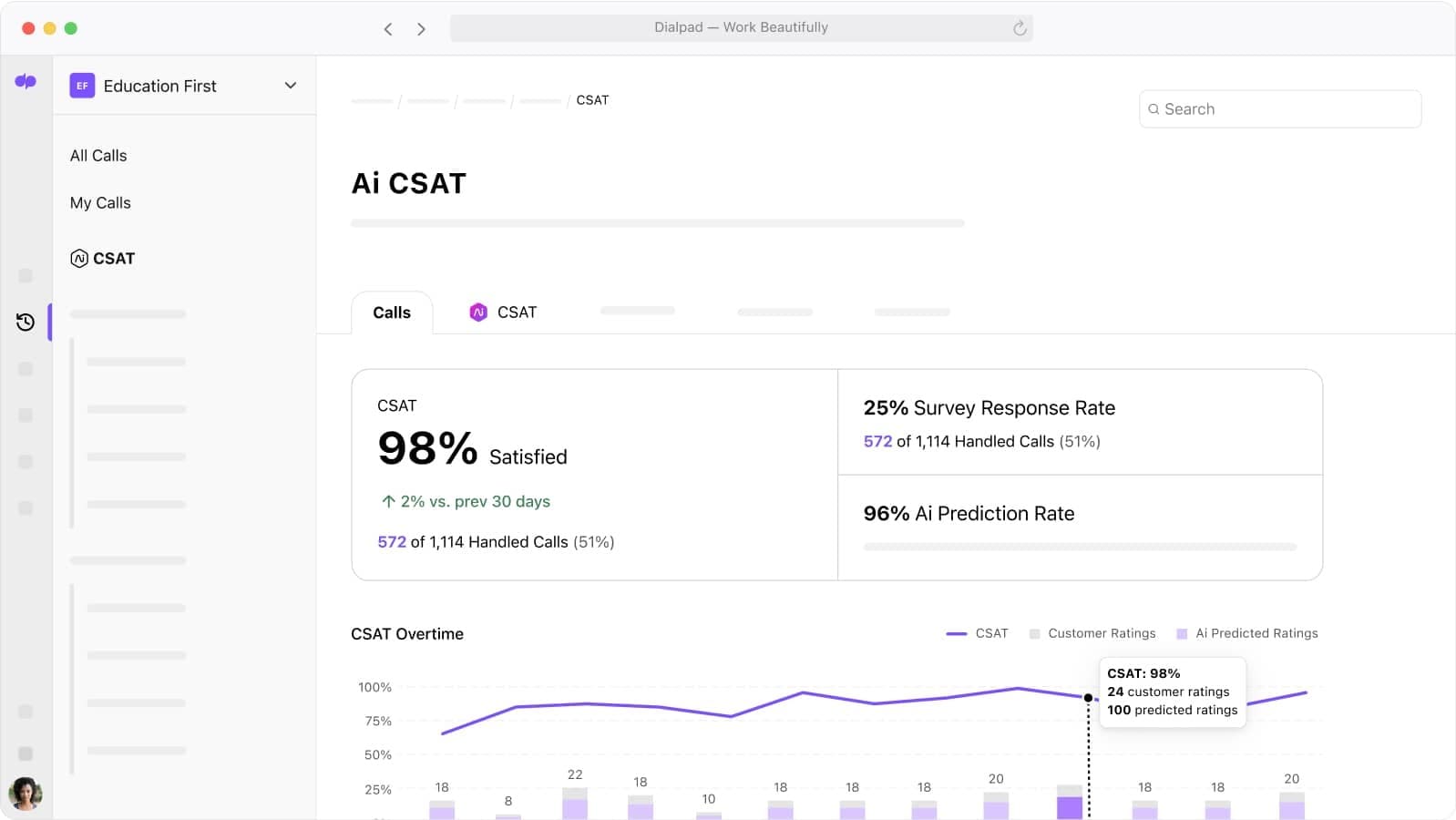
From a patient education perspective, AI-powered platforms can also deliver helpful, personalized patient education materials based on individual medical conditions, treatment plans, and preferences. If your AI tools can analyze patient data (like medical records and lifestyle factors), it could use that information to provide tailored educational content.
Not only does this improve patient engagement, it also empowers patients to make more informed decisions about their health and improves adherence to treatment plans.
AI in customer communications for banks and financial services firms
When it comes to banking, wealth planning and management firms, and other financial services businesses, AI can be used in client communications in a few ways to provide a better customer experience and ensure regulatory compliance.
Conversational AI and chatbots can handle everyday banking inquiries, like checking account balances, transaction history, fund transfers, and account management. These conversational interfaces can offer personalized recommendations, answer frequently asked questions, and provide guidance on financial products and services.
On a related note, AI can help with compliance support—banks and financial services firms have to adhere to industry requirements, and agents who handle transactions and questions on calls and messages are always at risk for potential regulatory violations.
For example, Dialpad’s Ai Scorecards can automatically analyze conversations and suggest if agents have done the tasks listed in the quality assurance criteria. (Did the agent verify the client’s identity by asking all the required questions?)
AI can also send notifications and alerts to provide updates on account balances, payment due dates, and personalized offers for customers. From a practical perspective, these timely notifications keep customers informed. But from a marketing and customer experience perspective, they also keep them engaged with the brand.
AI in customer communications for ecommerce businesses and retailers
There are several ways AI can be used in customer communications if you run an ecommerce business such as dropshipping.
AI can provide personalized product recommendations (Google is all over this), with algorithms that can analyze customer data (like purchase history, browsing behavior, and demographic information).
I don’t know about you, but I’ve received more than a few emails from stores I’ve bought from in the past, with new “recommended products” that they know will just be perfect for me.
Of course, conversational AI and chatbots can also handle customer questions, provide support, and help with common tasks like tracking orders and processing returns.
If you don’t have the budget to have agents working around the clock, then another benefit is that conversational AI can operate 24/7. (This matters especially if you have customers around the world in different time zones.)
How are you using AI in communication with your teams and customers?
Whether you’re in a customer-facing role or not, AI can help make your daily communications more productive and more efficient in different ways. From summarizing your meetings so that teammates can easily catch up on what they missed, to drastically improving the customer experience, there’s a plethora of customer service AI and sales AI apps and solutions you can use.
And Dialpad gives you a wide variety of these helpful tools! Why not get a hands-on look at how it works?
Communicate more effectively with AI
Let our team show you how Dialpad Ai can help with both your internal and external communications. Or, take a self-guided interactive tour of the app first!









